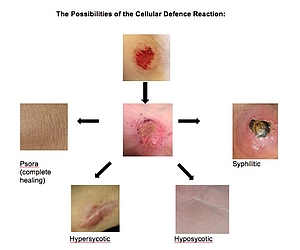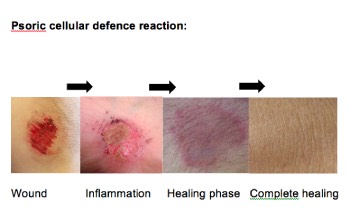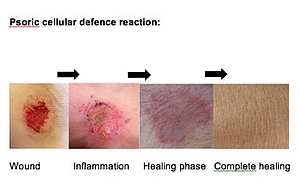2.) Treat the miasm, not the symptoms
In the Organon (6thedition) Samuel Hahnemann writes:
§ 205
The homoeopathic physician never treats one of these primary symptoms of chronic miasms, nor yet one of their secondary affections that result from their further development, by local remedies (neither by those external agents that act dynamically,1 nor yet by those that act mechanically), but he cures, in cases where the one or the other appears, only the great miasm on which they depend, whereupon its primary, as also its secondary symptoms disappear spontaneously; but as this was not the mode pursued by the old-school practitioners who preceded him in the treatment of the case, the homoeopathic physician generally, alas!, finds that the primary symptoms2 have already been destroyed by them by means of external remedies, and that he has now to do more with the secondary ones, i.e., the affections resulting from the breaking forth and development of these inherent miasms, but especially with the chronic disease evolved from internal psora, the internal treatment of which, as far as a single physician can elucidate it by many years of reflection, observation and experience, I have endeavored to point out in my work on Chronic Diseases, to which I must refer the reader.
The problem with miasmatic treatment is:
· Today, there are different definitions of the term miasm, and most of them are unclear– there is no clear,
functioning approach
· The causes and derivation of miasms are no longer up to date and contradict today's medical science
(formerly: by infection)
· The assignment to the miasms is very varied – what is even more varied is the prescription based on these
theories
· The miasms are often attributed to pathologies – but this limits individuality
· Reduced effect of many hom. remedies on the miasms and thus in the treatment of chronic diseases
· More and more new miasms are being invented and
Since Vijayakar trusted Hahnemann absolutely, he knew that miasm theory was valuable and important. He knew that Hahnemann is no longer properly understood today and was looking for a bridge between miasms back then and modern scientific medicine today. From logical conclusions, Vijayakar developed a new miasm model. They are no longer miasms in Hahnemann's sense. For Vijayakar, miasms are the body's reactions to stimuli.
2.1) The miasms according to Vijayakar:
"Can serious, chronic diseases be cured without considering miasms? Absolutely. But the inclusion of miasms makes it much easier and safer."
The theory of miasms according to Vijayakar:
· Symptoms or diseases are the body's response to a stimulus
· The body's reaction is always to fight or defend
· Diseases are defence mechanisms.
"Diseases are activated defence mechanisms."
The symptoms of our body are countermeasures produced by the dynamis to protect the organism from further disease or destruction.
Most organic diseases are caused by disturbances at the cellular level.
What types of defence, i.e. cellular reaction, are there?
· Inflammatory reaction
o primarily physiological defence
· Constructive adaptation reaction
o morphological constructive defence = structural change (expansion or reduction, increase or decrease)
· Destruction, degeneration = morphologically destructive defence (aptosis, necrosis)
2.1.1) Defence and Miasm
· Pathologies caused by inflammation and irritations seem to be based on physiological defence.
· Pathologies that lead to growth or proliferation seem to be based on constructive defence.
· Destructive pathologies seem to proceed from destructive defence.

The consequence for Prafull Vijayakar:
Psora = physiological defence
Sycosis = constructive defence, adaptation reaction
Syphilis = destructive defence
"If there is no other defence for the cell than those above, there can be only 3 miasms."
§ 74:
Among chronic diseases we must still alas reckon those so commonly met with, artificially produced in allopathic treatment .............. in order to maintain life against these inimical and destructive attacks, it must produce a revolution in the organism, and either deprive some part of its irritability and sensibilitiy, or exalt these to an excessive degree(according to Vijayakar this means psoric defence), cause dilatation or contraction, relaxation or induration (according to Vijayakar this means sycotic defence) or even total destruction of certain parts, and develop faulty organic alterations here and there in the interior or the exterior (cripple the body internally or externally), in order to preserve the organism from complete destruction of life by the ever-renewed, hostile assaults of such destructive forces.(according to Vijayakar, this means syphilitic defence).
It would have been more appropriate if Vijayakar had not called his theory and structure miasmic, but the three reaction mechanisms of the body or the equivalent. By using the term miasm, he alienates many homoeopaths.
2.1.2.) The MIASMIC CONSTITUTION
Vijayakar assigns the symptoms and pathologies to the respective cellular defence reaction of the body and names them miasmically as appropriate. He considers the mood symptoms as well as the general and local symptoms.
2.1.2.1.) The Psora
2.1.2.1.a.) Pathogenesis and symptoms of psora:
Defensive reaction to pathogens, toxins or emotional disorders:
· primarily physiological defence
· altered sensitivity, irritation
· acute inflammation
· the reaction is never permanent, i.e. temporary
· as soon as the cause has been removed, the normal condition is restored, it heals
· symptoms are variable, unstable and highly dynamic, i.e.
· symptoms are usually sudden, like an attack and characterised by severe pain and redness
· good response to treatment (homoeopathic and allopathic)
· most pain and discomfort that is temporary, recurrent and associated with high fever and rashes.
2.1.2.1.b) Psora diseases:
· These are symptoms caused by infection, inflammation and irritation
· including for simple reasons, e.g. changes in diet, the weather, emotions.
· SKIN: all acute inflammations, hypersensitivity and irritations. Pruritus, dermatitis, eczema. Wounds heal
without scarring and remain superficial, neither deep nor destructive
· RESPIRATORY TRACT: rhinitis, pharyngitis, tonsillitis, bronchitis, tracheitis, pneumonia, hypersensitivity
of the trachea causing asthmatic bronchitis, spasms
· GASTROINTESTINAL TRACT: oesophagitis, gastritis, hyperacidity, colitis, hyperperistalsis, diarrhoea,
acute hepatitis, acute appendicitis, irritation due to worms, irritable bowel syndrome, etc.
· MUSCULOSKELETAL SYSTEM: acute arthritis, joint cartilage inflammation, spondylitis, tendinitis.
· Acute states of confusion caused by drugs
· Supply disorders: iron deficiency, mineral deficiency, etc.
· Epilepsy due to fever convulsions or after mild traumas (psoro-syphilitic), i.e. temporary.
2.1.2.1.c) The psoric state of mind and spirit:
The psora always means the physiological reaction of the body first. The
mental and emotional state corresponds to the physical psoric reaction.
Here it is a question of the basic reactions of the human being, the initial reactions. These are:
sensitivity # fear # shyness # irritability # anger
2.1.2.1.d) Psora symptoms:
· sensitive, hypersensitive; discomfort, agitation
· irritability; hot-tempered, fiery, eager; complaining;
· anxiety; apprehensiveness, fear; full of worries, alarm; cautious, prudent, alert, compassionate
· inept, clumsy;
· bashful, overmodest
· moody, capricious;
· confusion
· brave, fearless, sober

sources:
Samuel Hahnemann, The Organon of the Healing Art, 6thedition according to the edition by Richard Haehl 1921, Haug Verlag
Dr. Prafull Vijayakar: The Laws of Miasms; Kristina Lotz Publishing House
Dr. Prafull Vijayakar at his seminar in Regensburg "Über den Grenzen" 2012, seminar notes by Oliver MüllerDr. Kavita Sawant - 24.09.09; seminar transcript from Renate Greißl
picture:
public domain 30.07.2019
